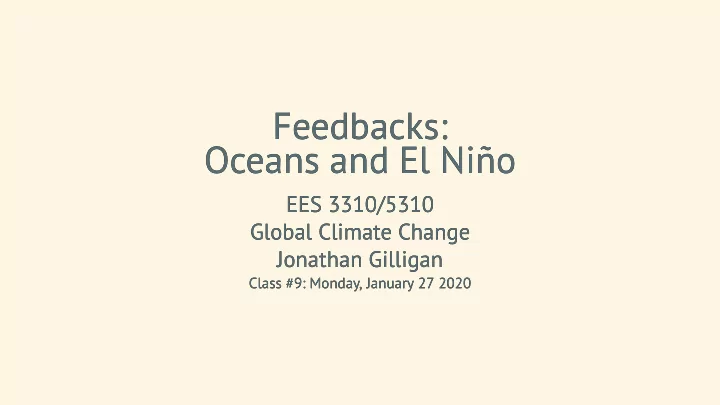

Feedbacks: Feedbacks: Oceans and El Niño Oceans and El Niño EES 3310/5310 EES 3310/5310 Global Climate Change Global Climate Change Jonathan Gilligan Jonathan Gilligan Class #9: Class #9: Monday, January 27 Monday, January 27 2020 2020
Announcement Announcement Professor Gilligan’s office hour on Tuesday Jan. 28 is cancelled. I will have my regular office hour on Wednesday Jan. 29.
Kombayashi-Ingersoll Limit Kombayashi-Ingersoll Limit Outgoing long-wave has to balance incoming sunlight no feedback, feedback, feedback + high CO 2 Brighter sun hotter more water vapor → → Kombayashi-Ingersoll limit: Sunlight below limit, there is a stable equilibrium with liquid water Sunlight above limit: Runaway greenhouse effect Oceans boil dry Earth is well below the limit Venus is well above the limit Rain and surface-water is important for removing CO 2 from atmosphere Without liquid water Venus’s CO 2 went out of Image credit: R. Pierrehumbert, Nature 419 , 191 (2002) doi: 10.1038/nature01088 control 220,000 times more CO 2 than Earth’s atmosphere
Cloud Feedbacks Cloud Feedbacks
Cloud Feedbacks Cloud Feedbacks What effect do clouds have on climate? What effects does climate have on clouds? Warmer more clouds → More clouds: Higher albedo (cools earth: negative feedback) High emissivity: blocks longwave light (warms earth: positive feedback) Which effect is bigger?
Cirrus Clouds (High) Cirrus Clouds (High)
Stratus Clouds (Low) Stratus Clouds (Low)
Cloud Feedbacks Cloud Feedbacks Image credit: L.R. Kump, J.F. Kasting, & R.G. Crane, The Earth System , 2nd ed. (Pearson, 2004), p. 50
Satellite Measurements Satellite Measurements Radiative forcing by clouds Radiative forcing by clouds Image credit: NASA CERES/Terra experiment, Net Cloud Radiative Forcing, Nov. 2007 https://ceres.larc.nasa.gov/documents/press_releases/images/netcrf_small.png (negative = cooling, positive = warming)
Indirect Aerosol Effect Indirect Aerosol Effect
Indirect Aerosol Effect Indirect Aerosol Effect Aerosol particles more, smaller droplets → Smaller droplets greater albedo, longer lifetime → More droplets greater albedo, more absorption → Image credit: J. Houghton, Global Warming: The Complete Briefing , 4th ed. (Cambridge, 2009), p. 61
Indirect Aerosol Effect Indirect Aerosol Effect Image credit: NASA Earth Observatory, Ship Tracks South of Alaska, Mar. 4 2009. https://earthobservatory.nasa.gov/images/37455/ship-tracks-south-of-alaska
Summary of Feedbacks Summary of Feedbacks
Summary of Feedbacks Summary of Feedbacks Image credit: IPCC 5th Assessment Report, Climate Change 2013: The Scientific Basis , Ch. 9, Fig. 9.43. https://www.ipcc.ch/report/ar5/wg1/evaluation-of-climate-models/fig9-43-2/
Stefan-Boltzmann Feedback Stefan-Boltzmann Feedback The biggest feedback in the climate system is the Stefan-Boltzmann feedback. Stefan-Boltzmann equation: I = εσ T 4 Q = Q in − Q out Higher temperature more heat out to space → gets larger, so Q out Δ Q < 0 Δ T > 0 → Δ Q < 0 : negative feedback Δ Q f = < 0 Creates stable climate Δ T
Stefan-Boltzmann Feedback Stefan-Boltzmann Feedback Bare rock: Bare rock: T 4 I out = ϵσ m − 2 K − 1 f SB = − 3.2 W Forcing: m − 2 Q forcing = I in − I out = +1 W Δ T = − Q forcing / f − 1 Wm − 2 Δ T = = +0.32 K − 3.2 Wm − 2 K − 1
Positive & Negative Feedback Positive & Negative Feedback Total feedback: f = f 0 + f 1 + f 2 + ⋯ : Stefan-Boltzmann f 0 = f SB Other feedbacks : f 1 f 2 , , ⋯ Positive ( ): amplifies temperature change f 1 f 2 , , . . . > 0 Warmings hotter → Coolings colder → Negative ( ): diminishes temperature change f 1 f 2 , , . . . < 0 Warmings milder → Coolings milder →
Stability of the Climate Stability of the Climate Most feedbacks we’ve discussed are positive: Ice-albedo Water vapor Clouds (mostly) Why don’t these positive feedbacks make the climate unstable? (e.g., runaway greenhouse) They are smaller than the negative Stefan-Boltzmann feedback so the total feedback remains negative. Positive feedbacks amplify warming: More than we’d get with just Stefan-Boltzmann feedback, But they are too small to destabilize the planet. Some scientists worry about a possible “tipping point”: Is there a temperature threshold where positive feedbacks become greater than Stefan- Boltzmann? This would destabilize the climate. Venus-style runaway greenhouse effect seems impossible. But some uncontrolled warming is possible.
El Niño/Southern Oscillation El Niño/Southern Oscillation
Normal Conditions Normal Conditions Image credit: O. Heffernan, Nature Climate Change 4 , 167 (2014). doi 10.1038/nclimate2149
El Niño El Niño Image credit: O. Heffernan, Nature Climate Change 4 , 167 (2014). doi 10.1038/nclimate2149
Schematic of ENSO Wind & Temperature Schematic of ENSO Wind & Temperature Image credit: National Oceanic & Atmospheric Administration, Multivariate ENSO Index Version 2 https://www.esrl.noaa.gov/psd/enso/mei/
Multivariate El-Niño Index (MEI) Multivariate El-Niño Index (MEI)
Climate Connection Climate Connection El Niño phase: La Niña phase: Hotter sea-surface Cooler sea-surface More evaporation Less water vapor Bigger greenhouse effect Smaller greenhouse effect Higher global air temperatures Cooler global air temperatures
Biosphere Feedbacks Biosphere Feedbacks
Hydrological Cycle Hydrological Cycle Transpiration in plants: Roots take water from ground Leaves emit water vapor Evaporation cools the air Can be an important source of water vapor Image credit: NASA/JPL-Caltech https://climatekids.nasa.gov/heat-islands/
Transpiration and CO Transpiration and CO 2 Transpiration occurs through “stomata” in leaves Tradeoff: stomata Allow plant to get CO 2 Cause plant to lose water More CO 2 in atmosphere: Fewer stomata Less transpiration Image credit: Photo of stomata on duckweed: Micrographia http://www.micrographia.com/specbiol/plan/planaq/plaq0100/lemna-01.htm . Diagram of response to CO 2 : University of California Museum of Paleontology’s Understanding Evolution http://evolution.berkeley.edu .
Forests vs. Grasslands Forests vs. Grasslands Image credit: R.B. Jackson et al ., Environ. Res. Lett. 3 , 044006 (2008). doi: 10.1088/1748-9326/3/4/044006
Carbon Cycle Feedbacks Carbon Cycle Feedbacks Dead organic matter in ground (leaves, roots, etc.) stores carbon Warming temperatures accelerate decomposition Bacterial/fungal metabolism Huge amounts of dead organic matter in arctic tundra & permafrost Concerns about accelerated greenhouse gas emissions as ground thaws & warms Image credit: K. Schaefer et al. , Environ. Res. Lett. 9 , 085003 (2014). doi: 10.1088/1748-9326/9/8/085003
Recommend
More recommend